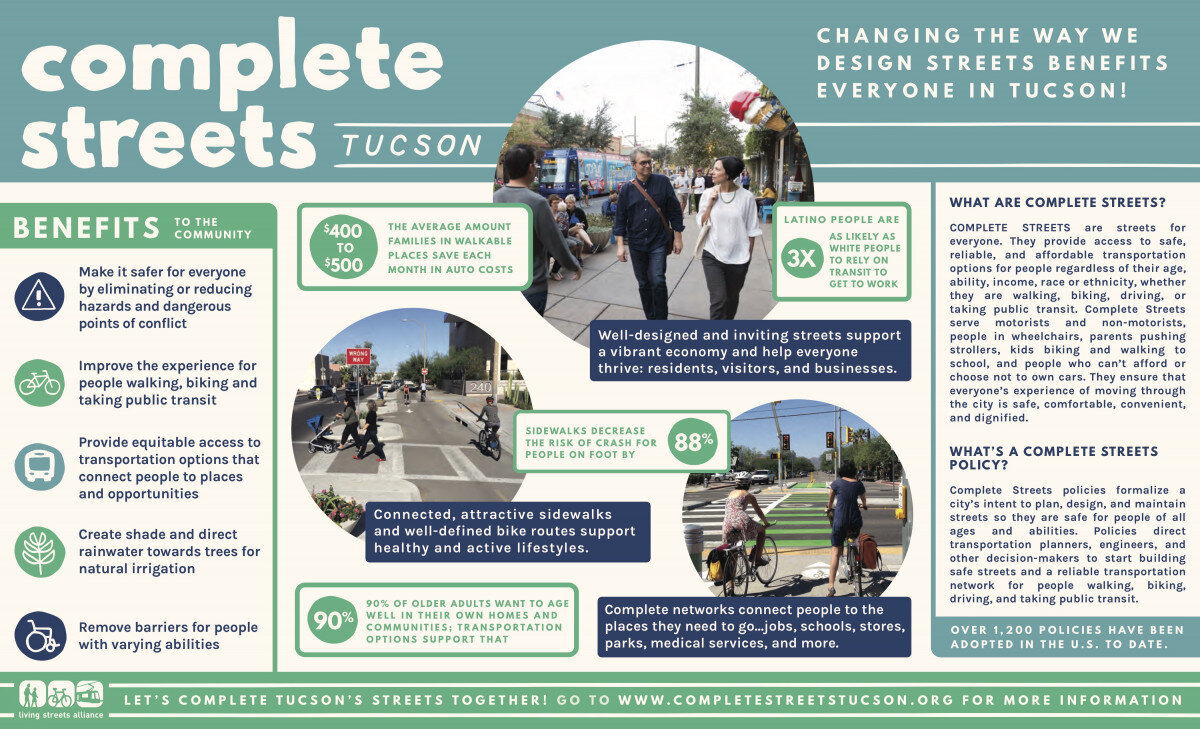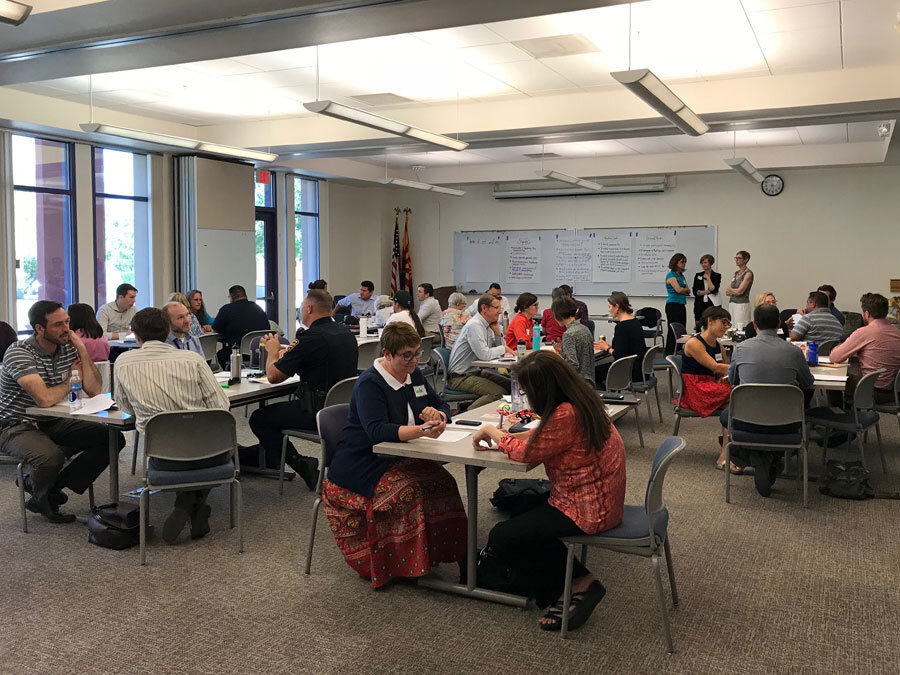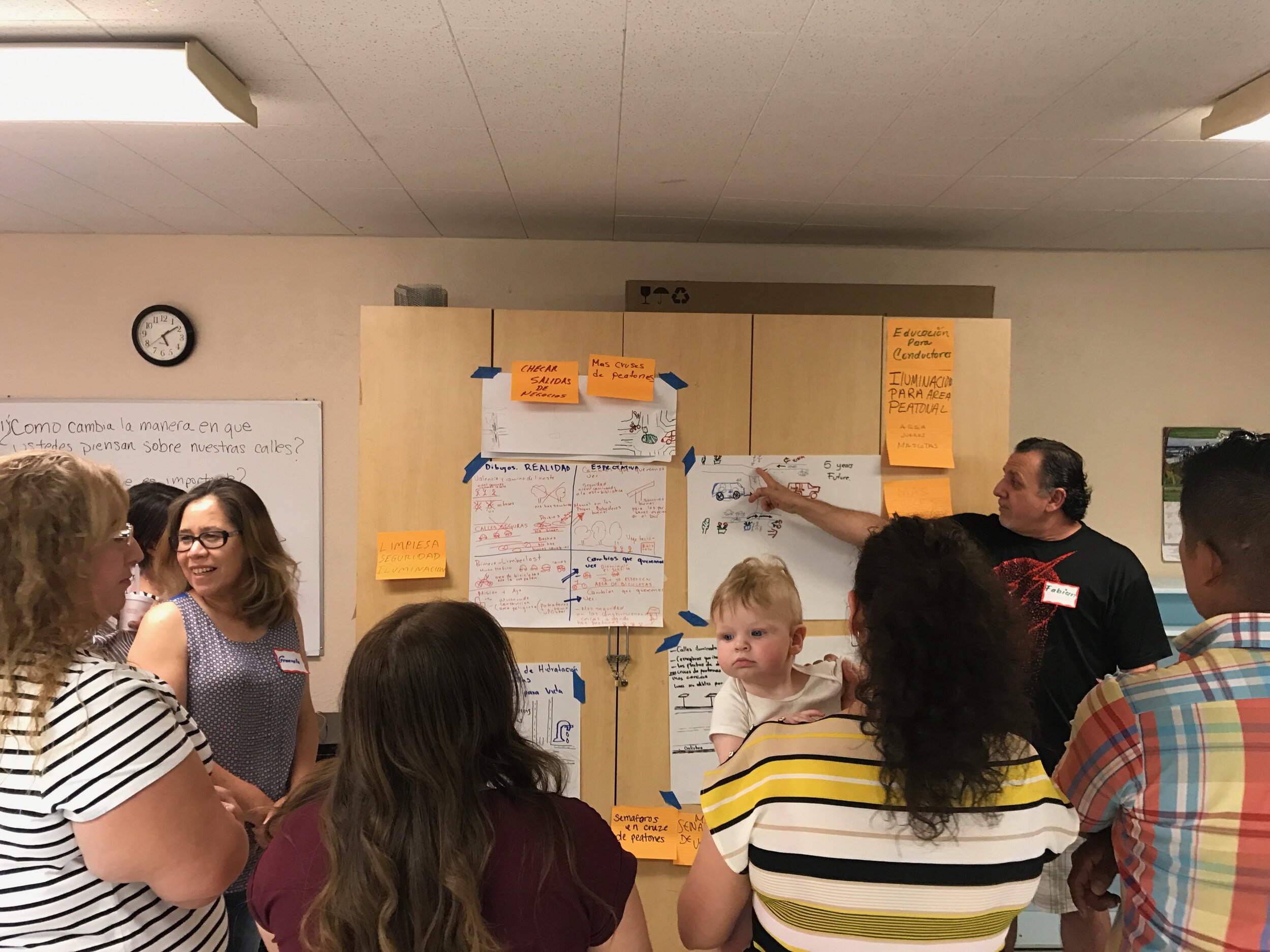Complete Streets is a way of designing and building our streets that focuses on creating a safe and welcoming experience for all people regardless of their age, ability, income, race, or ethnicity, whether they are walking, biking, driving, or taking public transit; they ensure streets balance the needs of people as they get around in different ways.
In October 2016, Living Streets Alliance received a grant from Voices for Healthy Kids, a joint initiative of the American Heart Association and the Robert Wood Johnson Foundation, to pursue a robust and equitable Complete Streets policy for Tucson. LSA celebrated a major policy win in 2019 when Tucson Mayor & Council unanimously adopted a strong Complete Streets Policy. The policy was a culmination of three years of strong advocacy by LSA that entailed community visioning, nontraditional engagement, and elevating disenfranchised voices. Read on to learn more about our community engagement efforts that helped inform the policy.

Community-Led Policy Development 2016-2018
Living Streets Alliance worked closely with the City of Tucson Dept. of Transportation & Mobility to develop a policy rooted in community need and vision. To this end, LSA spearheaded a variety of strategies to bring different voices to the table and provide multiple access points for engaging in the conversation about Complete Streets in Tucson. The following are key tactics utilized in the Complete Streets policy development process, many of which can also be found in our Complete Streets Community Engagement Toolkit that we created to help guide other communities as they develop their own complete streets policies.
Messaging & Communications
Making sure that people across the spectrum could relate to and understand complete streets was key, so we developed a suite of info sheets, videos, and ways to communicate about Complete Streets
Complete Streets Tucson overview (video)
Complete Streets Info Sheets
Complete Streets Supporter Postcard
Inspiring Others
We implemented a variety of tactics and strategies to highlight the need for complete streets and make it both exciting and urgent that they start happening now in Tucson
“What Moves You” Complete Streets Stories from real Tucsonans
The following videos were produced during a "What Moves You?" digital storytelling workshop hosted by Living Streets Alliance and Creative Narrations in September 2017. This was a way to bring real voices into the Complete Streets policy development conversation and amplify lived experiences of Tucsonans as they move through the city from day to day.
Complete Streets 101
A common misconception is that a “complete street” is one single thing; that they all look and act the same way. That, in fact, is pretty much the opposite of what complete streets are. Instead of streets being uniformly designed, the idea with complete streets is that they are sensitive to their surrounding contexts and the needs of the people in and moving through the area. This means that a “complete street” in a bustling urban business district might look very different than a “complete streets” in a rural or suburban neighborhood.
To help local leadership and staff understand exactly what complete streets means, we brought in the experts, Veronica Davis and Emiko Atherton of the National Complete Streets Coalition, to explain.
What is a Complete Streets policy?
In its simplest definition, public policy refers to the principles that guide the actions of a governmental body. Complete Streets policies are guiding documents that formalize a community’s intent to plan, design, build, and maintain streets that provide safe and convenient transportation options to get around to everyday destinations. They guide communities to consistently fund, build, and maintain the streets to serve all people using them, including people walking, bicycling, taking public transportation, and driving cars or commercial vehicles.
Here’s a presentation by Emiko Atherton, the Director of the National Complete Streets Coalition, explaining how Complete Streets policies work from the same workshop we hosted here in Tucson in 2017.
Complete Streets Policy Development Workshop - Tucson, AZ 9/29/2017
Honoring Victims of Traffic Violence
In November 2017, in observance of the World Day of Remembrance for Road Traffic Victims, Tucsonans gathered at City Hall for a vigil to remember and honor the lives of people who died in traffic crashes and issue a call to action for safe streets in Tucson. This was the culmination of a series of activities leading up to it, including the installation of ghost silhouettes at all locations where people had been killed in traffic crashes in 2017 around Tucson. It was a sobering and powerful moment, making clear the urgency for streets to be designed and built to prioritize the safety of every single person using them.
World Day of Remembrance for Road Traffic Victims, November 19, 2017, Tucson, AZ
From Complete Streets to Thriving Communities
One of the most inspiring people on the planet, when it comes to getting excited about the way cities could and should look and feel, is Gil Penalosa, founder of the original Ciclovia open streets program in Bogota, Colombia. We invited Gil in to host a series of talks and activities with different groups in Tucson. Here’s a recording of his talk at The Rialto Theater titled From Complete Streets to Thriving Communities
Gil Penalosa at The Rialto Theatre, April 5th, 2018
Demonstrating what’s possible
In October 2018, through a AARP Community Challenge grant, and in partnership with the Tucson Dept. of Transportation & Mobility, LSA and teams of volunteers helped transform the intersection of 6th Avenue and 7th Street into a vibrant, cheerful, and people-centered place.
The goal was to use low cost and temporary materials like planters, paint, and flexible posts, to clearly demarcate the spaces for cars and the spaces for people, effectively demonstrating what a “complete streets” approach to the intersection would yield.
Complete Streets Demonstration Project, October 2018, Tucson, AZ
Informing & Guiding the Policy
Key to Tucson’s Complete Streets policy success was that it be rooted in community vision. To ensure multiple points of access for informing the policy, we created a number of activities to engage people in conversations that would lead to clear and concrete direction of what to include in the policy.
Complete Streets Task Force
In partnership with Tucson Dept. of Transportation & Mobility, and working with two independent consultants, we convened a Complete Streets Task Force to serve as the “custodians” of the policy as it was drafted, refined, evolved, and was eventually adopted. The Task Force included representation from various local government departments as well as non-governmental stakeholders representing diverse sectors and issue areas (affordable housing, public health, economic development, local business, food justice, shade/green infrastructure, etc.), as well as constituencies (youth, older adults, persons with disabilities, low-income households, public transit users, etc.).
Rethinking Streets Community Dialogue Workshops
Part of our community engagement strategy included a series of "Rethinking Streets" workshops built upon the Appreciative Inquiry approach. Participants worked together to articulate their vision for Tucson’s streets and arrive at shared themes and recommendations to help guide the policy.
Rethinking Streets workshops were hosted at times and locations requested by different groups to demonstrate an approach focused on meeting people where they are. Through these workshops, we were able able to reach communities that are traditionally left out of government planning and decision-making processes such as youth with disabilities and undocumented immigrants.
Pop-up Engagements
To supplement the workshops and demonstrate an additional non-traditional engagement method that doesn’t require people to alter their daily routines to participate, we developed a pop- up community engagement model. Working with two youth partners, we conducted on-street engagement (in English and in Spanish) at everyday community destinations or places where community members are naturally convening. Pop-up events took place next to the downtown transit center, outside of a public library in Tucson’s primarily Latino south side, outside of a popular restaurant on the south side, and during a food pickup hosted by the Community Food Bank of Southern Arizona.









